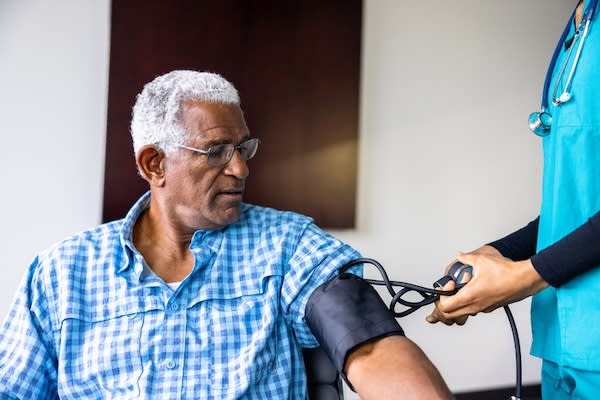Hypertension: Why it’s known as a silent killer

[3 MIN READ]
In this article:
-
Almost half of U.S. adults have high blood pressure, also called hypertension, but only 1 in 4 have their condition under control. Many don’t even know they have it.
-
Hypertension is often referred to as the silent killer because it doesn’t typically cause symptoms.
-
The only way to know whether you have hypertension is to have your blood pressure checked.
Hypertension: Why it’s known as a silent killer
Almost half — more than 119 million — of U.S. adults have high blood pressure, also called hypertension. Yet only about 1 in 4 of them have their condition under control. In fact, many don’t even know they have it.
Hypertension often doesn’t have any obvious symptoms. Instead, the only way to know whether your blood pressure is too high is to have it checked.
A closer look at hypertension
Blood pressure is the force caused by blood pushing against the arteries as your heart pumps blood throughout the body. If you have high blood pressure, it means blood is flowing through the arteries at a higher-than-normal pressure.
Risk factors for hypertension include:
- A certain genetic composition
- A family history of high blood pressure
- Being overweight or obese
- Drinking too much alcohol
- Eating a diet high in salt
- Not being physically active
- Older age
Racial and ethnic factors can also play a role. For example, the rate of high blood pressure among Black people in the United States is among the highest in the world. Around 55% of Black adults have hypertension, in fact.
People who are Hispanic also have a higher risk of developing hypertension.
How blood pressure is measured
Blood pressure is measured using two numbers, called systolic and diastolic pressures. Systolic pressure is the first, or top, number. It’s a measure of the pressure in your arteries when your heart beats. Diastolic pressure is the second, or bottom, number. It’s a measure of the pressure in your arteries between your heartbeats when your heart is relaxed.
Normal blood pressure is 120 (systolic)/80 (diastolic) or lower. Your blood pressure is considered high if it’s 130-139/80-89. If your blood pressure is between 120/80 and 129/89, it’s considered pre-hypertension.
Why hypertension often goes undetected
Hypertension is often referred to as the “silent killer.” According to the American Heart Association, three-quarters of people who have hypertension don’t know they have it. That’s because the condition doesn’t cause noticeable symptoms, but it does increase the workload of the circulatory system, which, over time, damages the arteries and leads to plaque buildup. This causes the arteries to narrow, which raises blood pressure.
American actor Jackie “Jocko” Sims was “one of those people” who didn’t know he had hypertension.
“I felt fine, but during a routine checkup, I learned my blood pressure and other health numbers were high,” he says. “I was stunned.”
Monica Ferguson, M.D., an internal medicine specialist at Providence Medical Group in Santa Rosa, California, says she also had hypertension without knowing it.
“I was actually diagnosed with high blood pressure a few years ago when I went to see my gynecologist,” she says. “I knew I was at high risk because high blood pressure is more common in African Americans. I also have a strong family history.”
The reason most people with hypertension don’t know they have it is because the condition doesn’t tend to cause any noticeable symptoms — although sometimes, if your blood pressure is very high, it can cause issues such as:
- An abnormal heart rhythm (or arrhythmia)
- Blurred vision
- Chest pain
- Dizziness
- Difficulty breathing
- Nausea and vomiting
- Severe headaches
Yet without treatment, hypertension can cause health conditions like heart disease, kidney and heart failure, and stroke.
Checking your blood pressure is the only way to know if you have hypertension. The best way to have your blood pressure measured is by a health care provider, who can tell you if you have hypertension or pre-hypertension and help you understand how your number may increase your risk for other health conditions.
You can also measure your blood pressure at home, using an automated device. But if you choose that route, you should follow up with a doctor to discuss what it could mean for your health.
The good news is that “there’s a lot you can do to manage high blood pressure,” Dr. Ferguson says, including making some lifestyle changes and taking medication if necessary.
Contributing caregiver

Monica Ferguson, M.D., is an internal medicine specialist at Providence Medical Group in Santa Rosa, California.
Find a doctor
If you are looking for a primary care provider or cardiologist, you can search for one who’s right for you in our provider directory.
Download the Providence app
It’s all in the app: easily stay connected with Providence and your health. With the Providence app, you can schedule appointments, have virtual visits from the comfort of your own home, get health recommendations personalized for you, access your health records and so much more. Learn more and download the app.
Related resources
Your comprehensive guide to heart health
Lowering hypertension in Black and Latinx communities
Five tips to lower blood pressure without medication
This information is not intended as a substitute for professional medical care. Always follow your health care professional’s instructions.
[KG1]Is Jocko’s video on YouTube? I’d love to embed it here or link to it, if possible.
[KG2]Same here: Would love to embed one of these videos and link to the other. But they will have to be posted on YouTube or another site before we can do that.


